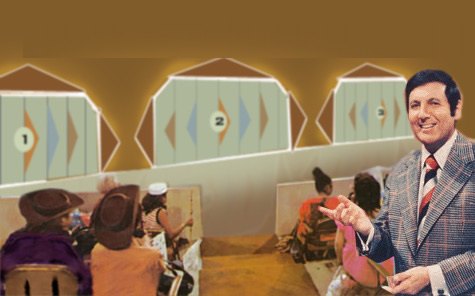It's well-known amongst the oldsters of the web, but it's time to introduce it to a new generation. So: The most famous nonintuitive puzzle in probability mathematics:
You're on a game show (the problem was named after the TV game show Let's Make A Deal, hosted by Monty Hall. You have three closed doors in front of you. You're told that two of the doors have a goat behind them, while the other door has a car behind it, but you don't know ahead of time which is which.
Let's belay all the devil's advocates who say they want a goat. You want a car.
The game works like this: You pick a door. Then Monty Hall opens one of the doors you did not pick, and shows you a goat behind it (he always picks a goat door). Now there's two doors left - one you picked, and the other you didn't pick. One has a car, and one has a goat. Now you get the opportunity to switch your decision to the other door, Either that, or you stay with what you've got. After you make this decision, all doors will be opened and you get whatever is behind the door you picked.
Now, what's your best strategy to win the car? Stay or switch?
The answer is that you switch. You win 2/3rds of the time if you switch, and lose only 1/3rd of the time when you stay with your initial pick.
Wikipedia has one of the most complete entries ever explaining the problem and all of the math behind it. However, what's really interesting is the story of the problem's history.
Cognitive psychologists have tested and studied people extensively on this, and no matter how far along we go on the scientific and mathematical literacy scale, the vast majority gets this problem wrong on the first guess. World-renowned Hungarian mathematician Paul Erdos first heard of the problem and got it wrong. But the most notable hullabaloo was when high-IQ columnist Marilyn vos Savant gave her answer to the problem in her column in Parade magazine... and in the ensuing months the magazine received nearly 10,000 letters from readers arguing with it, a thousand of those from readers who held PHD degrees or better. She argued back and forth with readers for months, and classrooms across the country started testing it with their own simulations an discovered that she was right.
For those of you wanting to test this out, we have these wonderful modern computers now that are so good at this. Here's just one Monty Hall simulator that's usable online.
The puzzle has also taken on a life of its own in the media, being the subject of a Mythbusters episode, several mystery TV series, stage magicians' acts, and classroom exercises. Alas, Discovery channel hordes their shows' videos on their own channel, so all I can embed is this funky video:
Now don't stay up all night puzzling over this!

